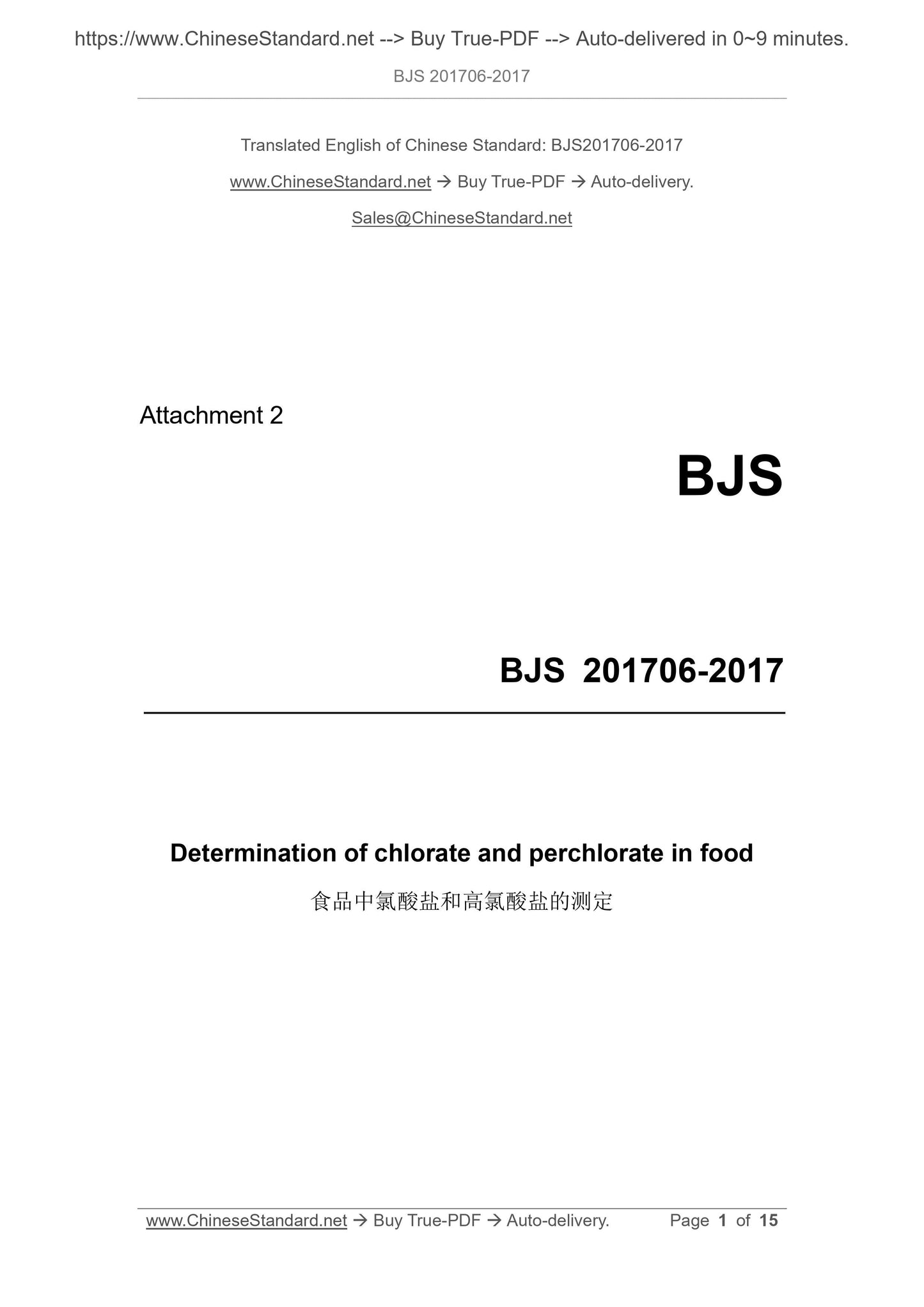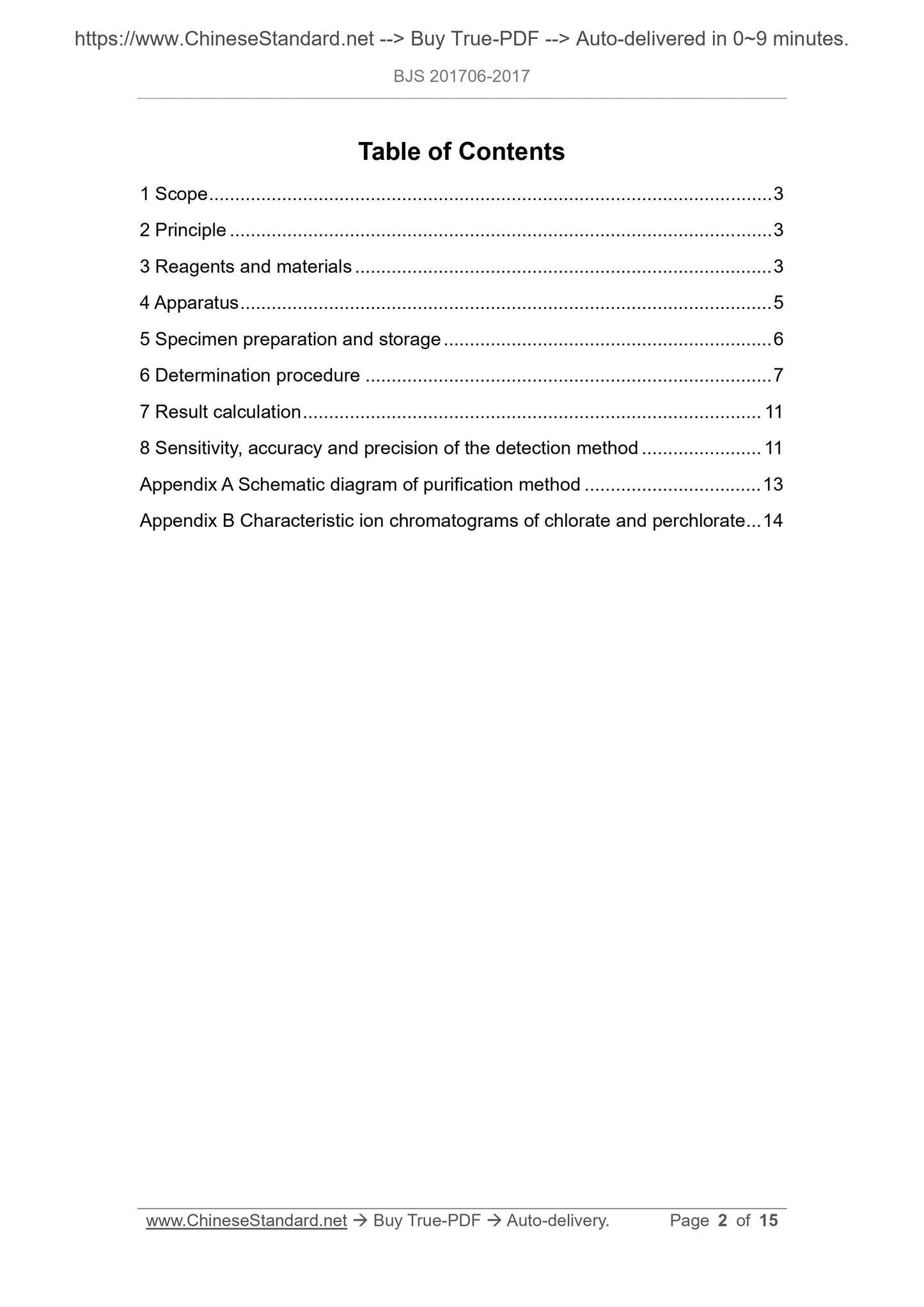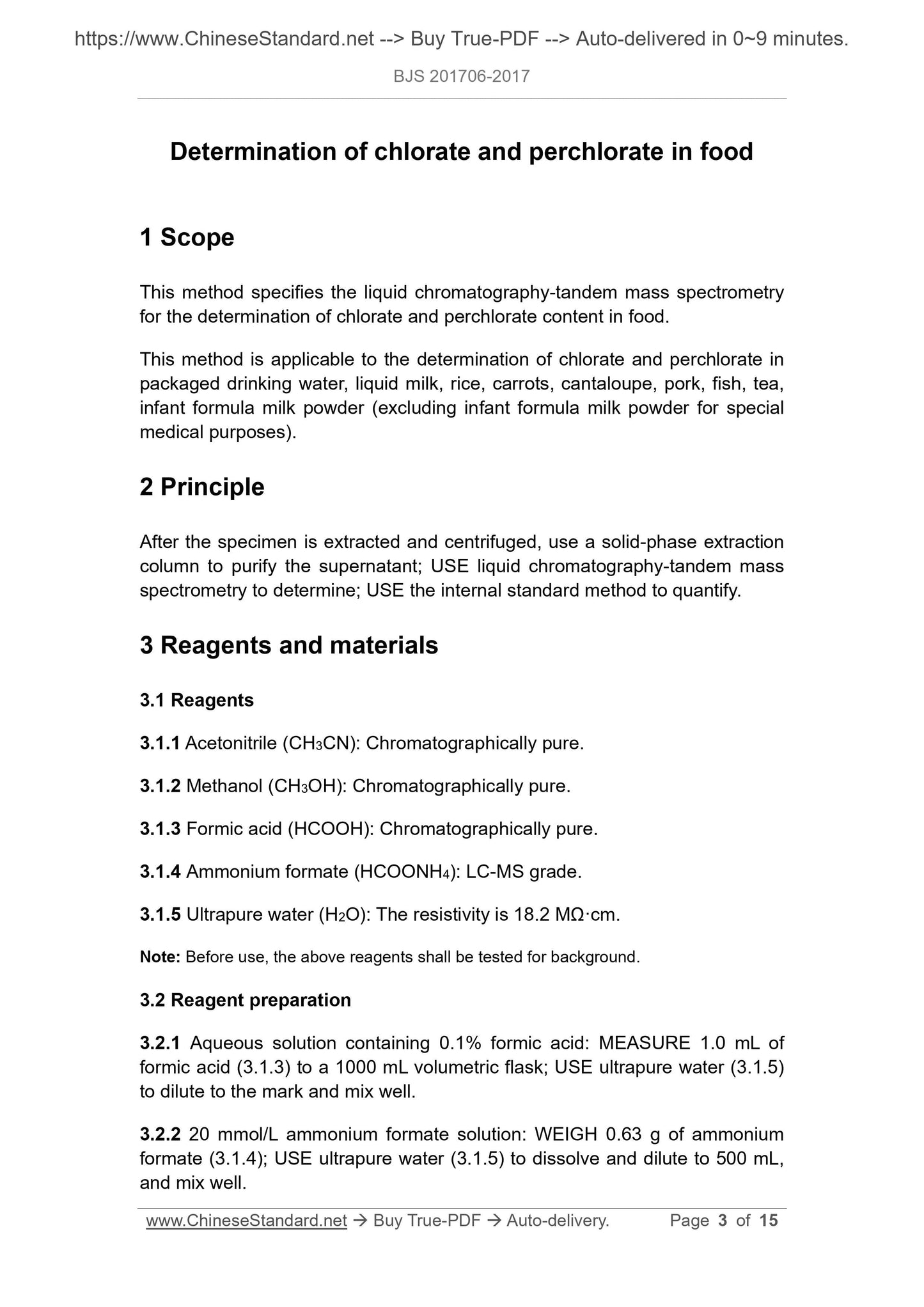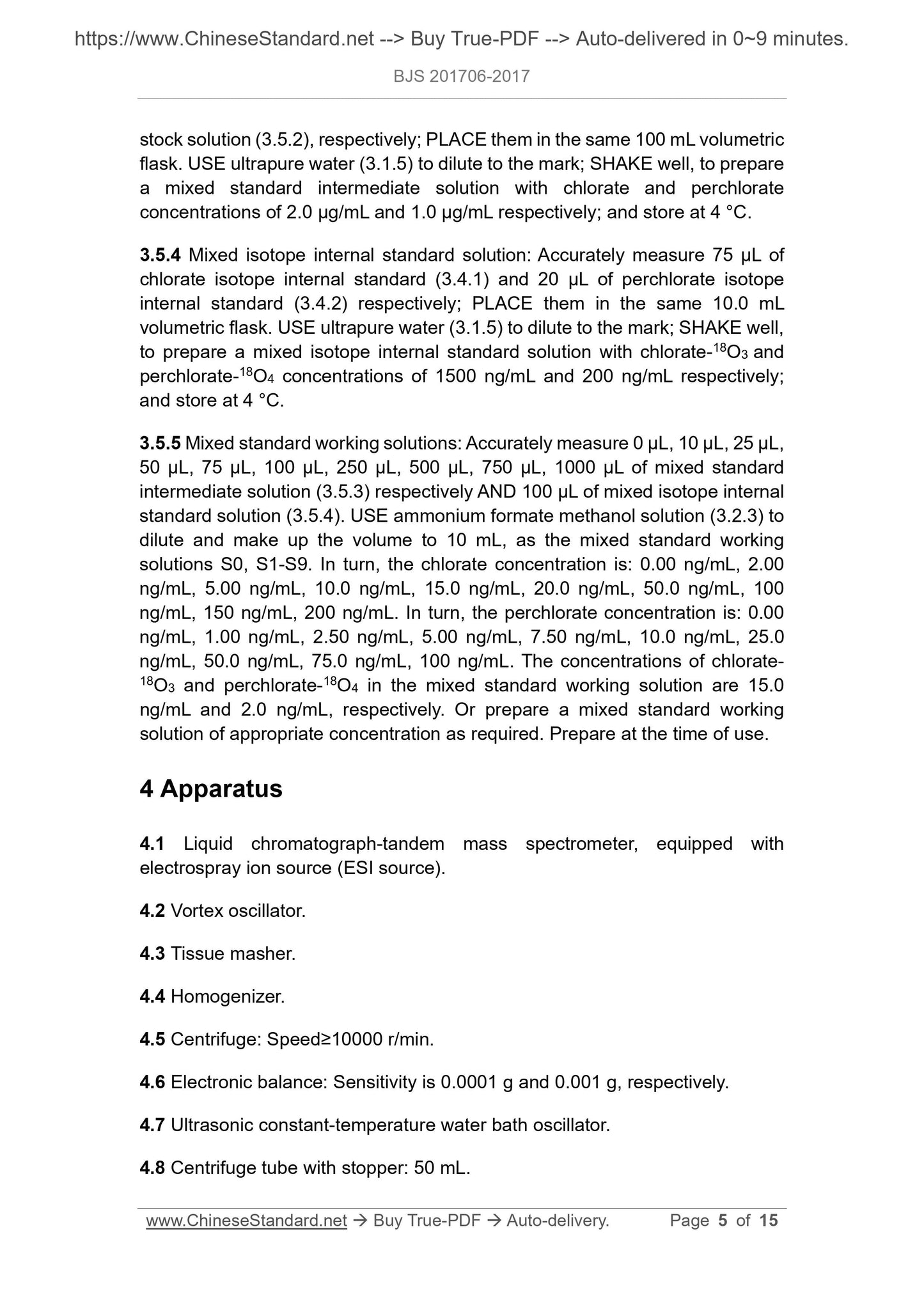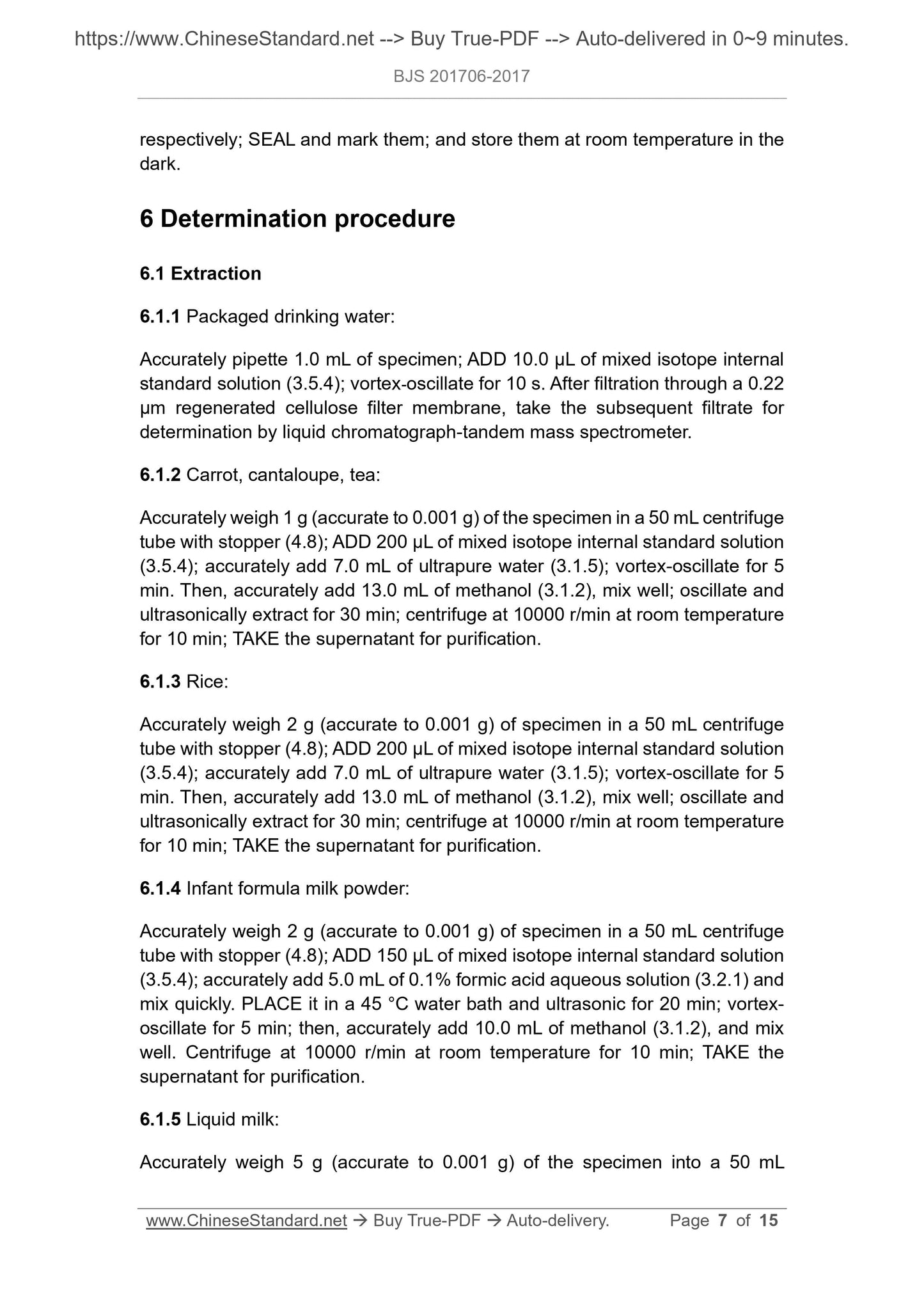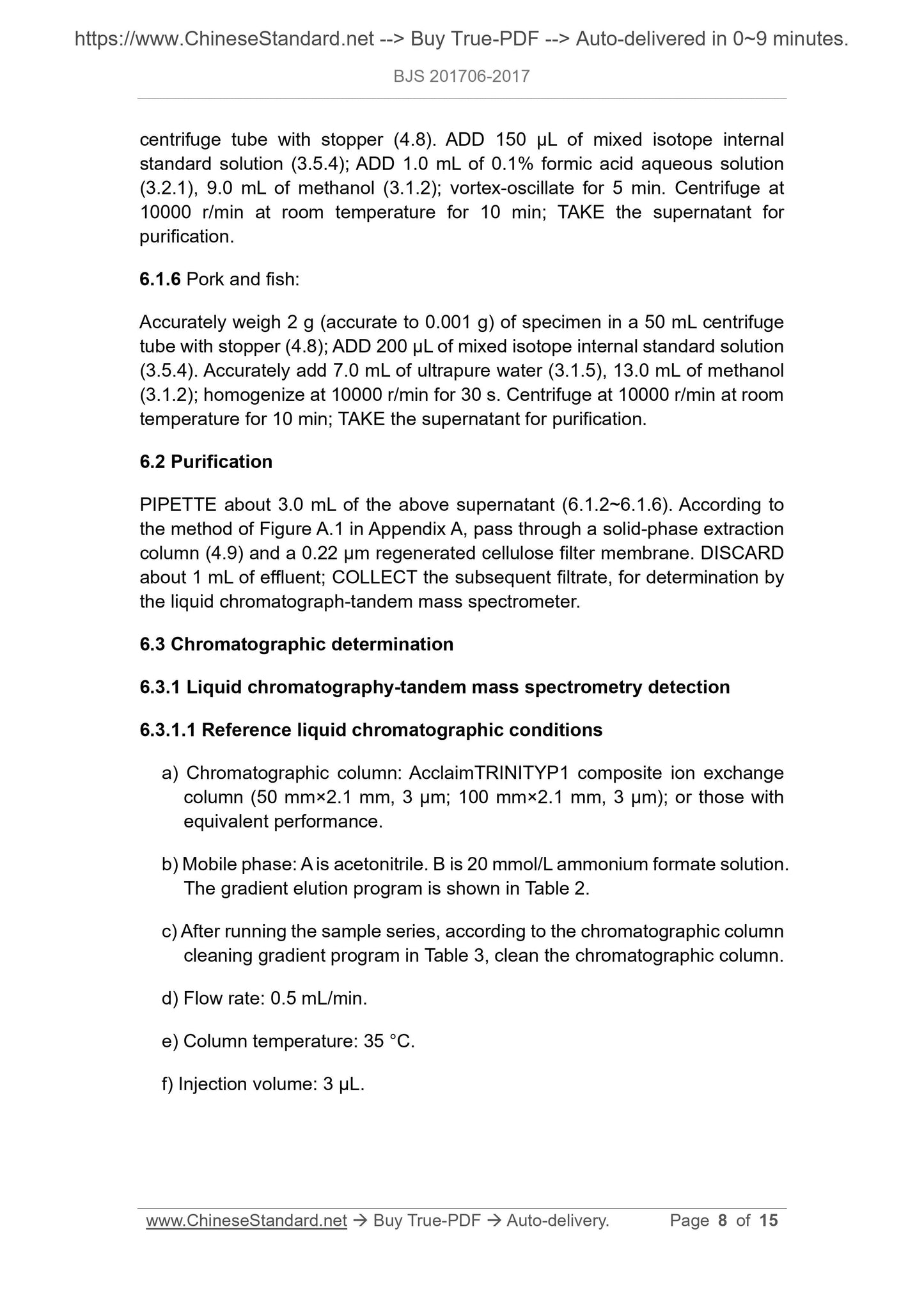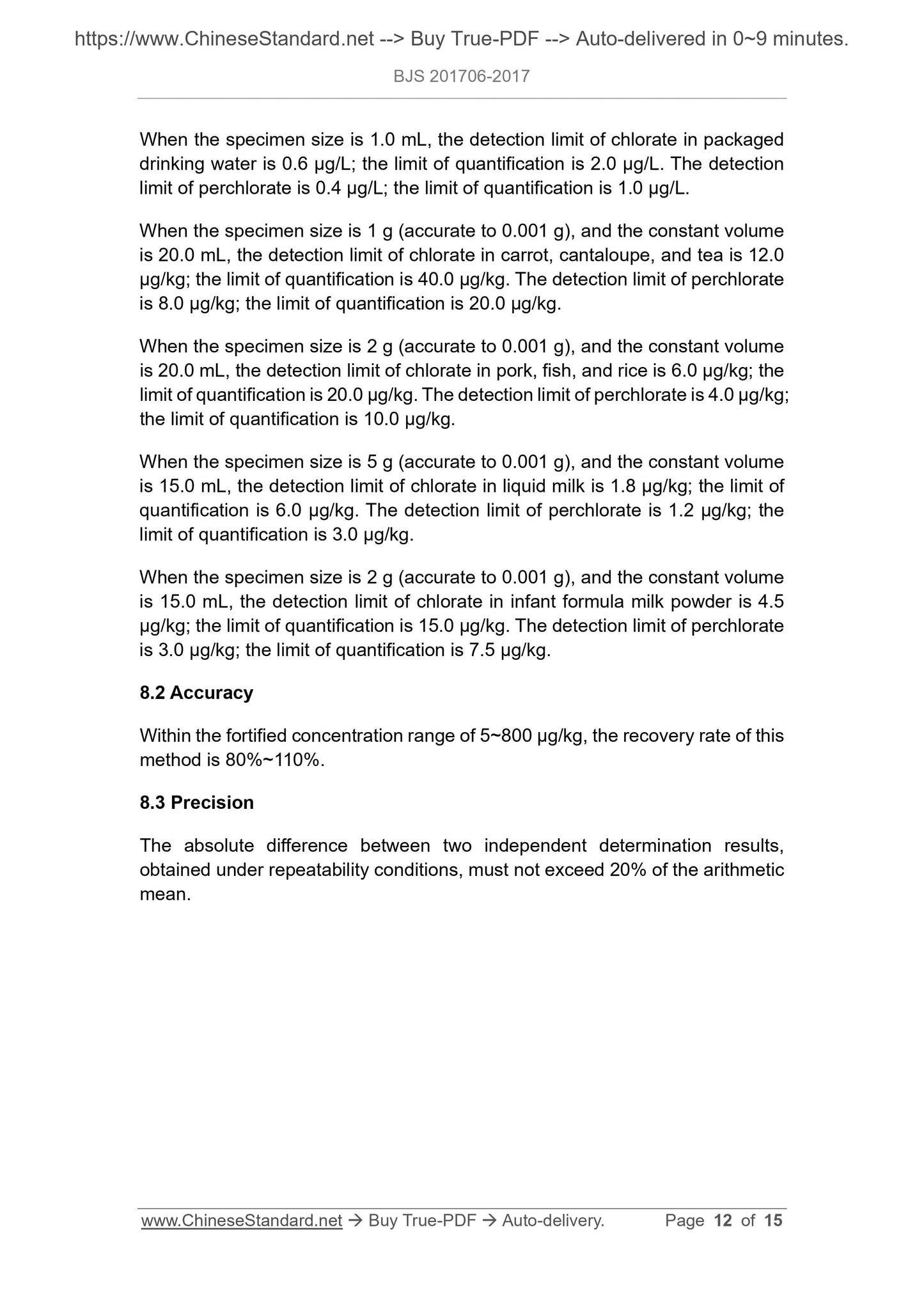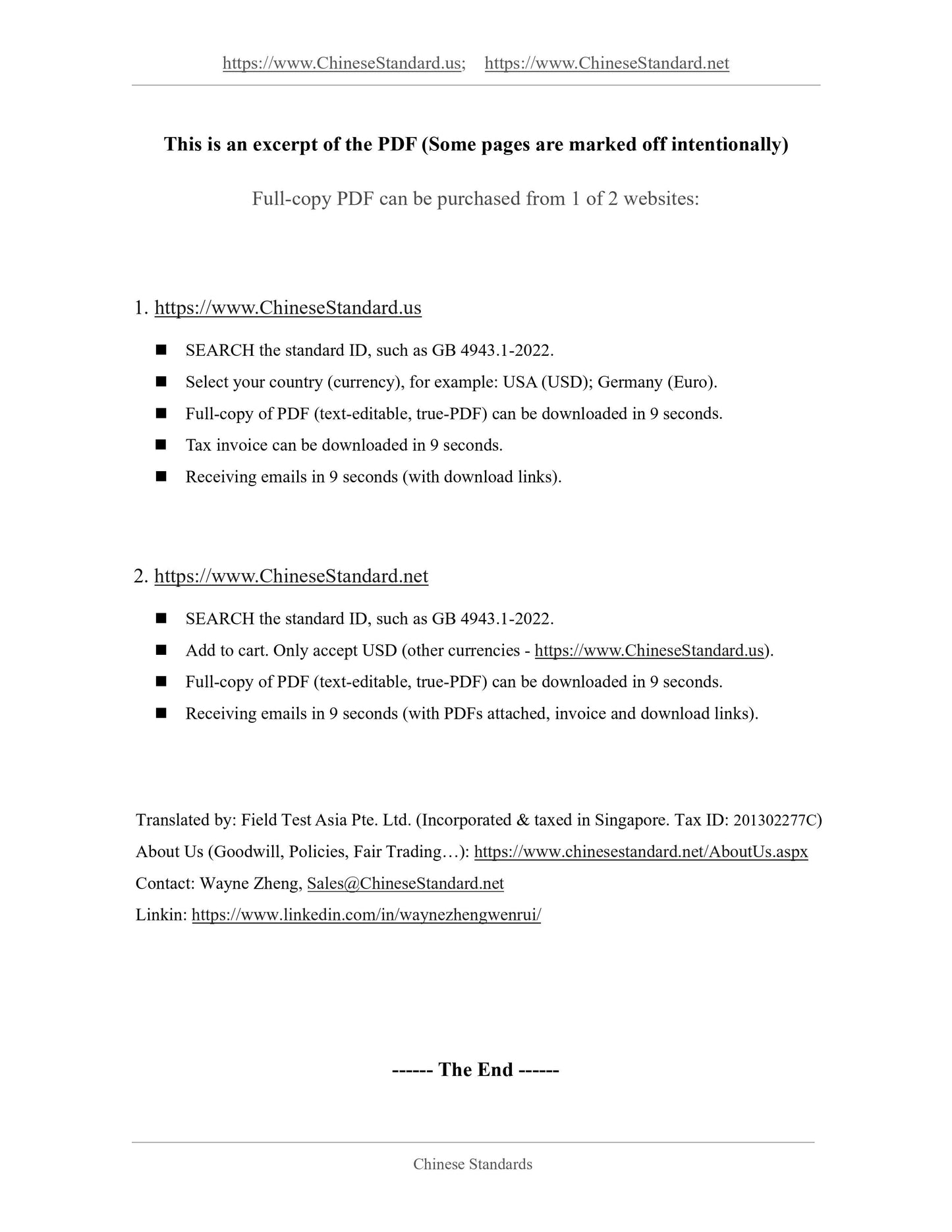1
/
из
8
PayPal, credit cards. Download editable-PDF and invoice in 1 second!
BJS 201706-2017 English PDF (BJS201706-2017)
BJS 201706-2017 English PDF (BJS201706-2017)
Обычная цена
$250.00 USD
Обычная цена
Цена со скидкой
$250.00 USD
Цена за единицу
/
за
Не удалось загрузить сведения о доступности самовывоза
Delivery: 2 working-hours manually (Sales@ChineseStandard.net)
Need delivered in 3-second? USA-Site: BJS 201706-2017
Get Quotation: Click BJS 201706-2017 (Self-service in 1-minute)
Historical versions (Master-website): BJS 201706-2017
Preview True-PDF (Reload/Scroll-down if blank)
BJS 201706-2017: Determination of chlorate and perchlorate in food
BJS 201706-2017
Attachment 2
BJS
Determination of chlorate and perchlorate in food
Table of Contents
1 Scope ... 3??
2 Principle ... 3??
3 Reagents and materials ... 3??
4 Apparatus ... 5??
5 Specimen preparation and storage ... 6??
6 Determination procedure ... 7??
7 Result calculation ... 11??
8 Sensitivity, accuracy and precision of the detection method ... 11??
Appendix A Schematic diagram of purification method ... 13??
Appendix B Characteristic ion chromatograms of chlorate and perchlorate ... 14??
Determination of chlorate and perchlorate in food
1 Scope
This method specifies the liquid chromatography-tandem mass spectrometry
for the determination of chlorate and perchlorate content in food.
This method is applicable to the determination of chlorate and perchlorate in
packaged drinking water, liquid milk, rice, carrots, cantaloupe, pork, fish, tea,
infant formula milk powder (excluding infant formula milk powder for special
medical purposes).
2 Principle
After the specimen is extracted and centrifuged, use a solid-phase extraction
column to purify the supernatant; USE liquid chromatography-tandem mass
spectrometry to determine; USE the internal standard method to quantify.
3 Reagents and materials
3.1 Reagents
3.1.1 Acetonitrile (CH3CN): Chromatographically pure.
3.1.2 Methanol (CH3OH): Chromatographically pure.
3.1.3 Formic acid (HCOOH): Chromatographically pure.
3.1.4 Ammonium formate (HCOONH4): LC-MS grade.
3.1.5 Ultrapure water (H2O): The resistivity is 18.2 M????cm.
Note: Before use, the above reagents shall be tested for background.
3.2 Reagent preparation
3.2.1 Aqueous solution containing 0.1% formic acid: MEASURE 1.0 mL of
formic acid (3.1.3) to a 1000 mL volumetric flask; USE ultrapure water (3.1.5)
to dilute to the mark and mix well.
3.2.2 20 mmol/L ammonium formate solution: WEIGH 0.63 g of ammonium
formate (3.1.4); USE ultrapure water (3.1.5) to dissolve and dilute to 500 mL,
and mix well.
stock solution (3.5.2), respectively; PLACE them in the same 100 mL volumetric
flask. USE ultrapure water (3.1.5) to dilute to the mark; SHAKE well, to prepare
a mixed standard intermediate solution with chlorate and perchlorate
concentrations of 2.0 ??g/mL and 1.0 ??g/mL respectively; and store at 4 ??C.
3.5.4 Mixed isotope internal standard solution: Accurately measure 75 ??L of
chlorate isotope internal standard (3.4.1) and 20 ??L of perchlorate isotope
internal standard (3.4.2) respectively; PLACE them in the same 10.0 mL
volumetric flask. USE ultrapure water (3.1.5) to dilute to the mark; SHAKE well,
to prepare a mixed isotope internal standard solution with chlorate-18O3 and
perchlorate-18O4 concentrations of 1500 ng/mL and 200 ng/mL respectively;
and store at 4 ??C.
3.5.5 Mixed standard working solutions: Accurately measure 0 ??L, 10 ??L, 25 ??L,
50 ??L, 75 ??L, 100 ??L, 250 ??L, 500 ??L, 750 ??L, 1000 ??L of mixed standard
intermediate solution (3.5.3) respectively AND 100 ??L of mixed isotope internal
standard solution (3.5.4). USE ammonium formate methanol solution (3.2.3) to
dilute and make up the volume to 10 mL, as the mixed standard working
solutions S0, S1-S9. In turn, the chlorate concentration is: 0.00 ng/mL, 2.00
ng/mL, 5.00 ng/mL, 10.0 ng/mL, 15.0 ng/mL, 20.0 ng/mL, 50.0 ng/mL, 100
ng/mL, 150 ng/mL, 200 ng/mL. In turn, the perchlorate concentration is: 0.00
ng/mL, 1.00 ng/mL, 2.50 ng/mL, 5.00 ng/mL, 7.50 ng/mL, 10.0 ng/mL, 25.0
ng/mL, 50.0 ng/mL, 75.0 ng/mL, 100 ng/mL. The concentrations of chlorate-
18O3 and perchlorate-18O4 in the mixed standard working solution are 15.0
ng/mL and 2.0 ng/mL, respectively. Or prepare a mixed standard working
solution of appropriate concentration as required. Prepare at the time of use.
4 Apparatus
4.1 Liquid chromatograph-tandem mass spectrometer, equipped with
electrospray ion source (ESI source).
4.2 Vortex oscillator.
4.3 Tissue masher.
4.4 Homogenizer.
4.5 Centrifuge: Speed???10000 r/min.
4.6 Electronic balance: Sensitivity is 0.0001 g and 0.001 g, respectively.
4.7 Ultrasonic constant-temperature water bath oscillator.
4.8 Centrifuge tube with stopper: 50 mL.
respectively; SEAL and mark them; and store them at room temperature in the
dark.
6 Determination procedure
6.1 Extraction
6.1.1 Packaged drinking water:
Accurately pipette 1.0 mL of specimen; ADD 10.0 ??L of mixed isotope internal
standard solution (3.5.4); vortex-oscillate for 10 s. After filtration through a 0.22
??m regenerated cellulose filter membrane, take the subsequent filtrate for
determination by liquid chromatograph-tandem mass spectrometer.
6.1.2 Carrot, cantaloupe, tea:
Accurately weigh 1 g (accurate to 0.001 g) of the specimen in a 50 mL centrifuge
tube with stopper (4.8); ADD 200 ??L of mixed isotope internal standard solution
(3.5.4); accurately add 7.0 mL of ultrapure water (3.1.5); vortex-oscillate for 5
min. Then, accurately add 13.0 mL of methanol (3.1.2), mix well; oscillate and
ultrasonically extract for 30 min; centrifuge at 10000 r/min at room temperature
for 10 min; TAKE the supernatant for purification.
6.1.3 Rice:
Accurately weigh 2 g (accurate to 0.001 g) of specimen in a 50 mL centrifuge
tube with stopper (4.8); ADD 200 ??L of mixed isotope internal standard solution
(3.5.4); accurately add 7.0 mL of ultrapure water (3.1.5); vortex-oscillate for 5
min. Then, accurately add 13.0 mL of methanol (3.1.2), mix well; oscillate and
ultrasonically extract for 30 min; centrifuge at 10000 r/min at room temperature
for 10 min; TAKE the supernatant for purification.
6.1.4 Infant formula milk powder:
Accurately weigh 2 g (accurate to 0.001 g) of specimen in a 50 mL centrifuge
tube with stopper (4.8); ADD 150 ??L of mixed isotope internal standard solution
(3.5.4); accurately add 5.0 mL of 0.1% formic acid aqueous solution (3.2.1) and
mix quickly. PLACE it in a 45 ??C water bath and ultrasonic for 20 min; vortex-
oscillate for 5 min; then, accurately add 10.0 mL of methanol (3.1.2), and mix
well. Centrifuge at 10000 r/min at room temperature for 10 min; TAKE the
supernatant for purification.
6.1.5 Liquid milk:
Accurately weigh 5 g (accurate to 0.001 g) of the specimen into a 50 mL
centrifuge tube with stopper (4.8). ADD 150 ??L of mixed isotope internal
standard solution (3.5.4); ADD 1.0 mL of 0.1% formic acid aqueous solution
(3.2.1), 9.0 mL of methanol (3.1.2); vortex-oscillate for 5 min. Centrifuge at
10000 r/min at room temperature for 10 min; TAKE the supernatant for
purification.
6.1.6 Pork and fish:
Accurately weigh 2 g (accurate to 0.001 g) of specimen in a 50 mL centrifuge
tube with stopper (4.8); ADD 200 ??L of mixed isotope internal standard solution
(3.5.4). Accurately add 7.0 mL of ultrapure water (3.1.5), 13.0 mL of methanol
(3.1.2); homogenize at 10000 r/min for 30 s. Centrifuge at 10000 r/min at room
temperature for 10 min; TAKE the supernatant for purification.
6.2 Purification
PIPETTE about 3.0 mL of the above supernatant (6.1.2~6.1.6). According to
the method of Figure A.1 in Appendix A, pass through a solid-phase extraction
column (4.9) and a 0.22 ??m regenerated cellulose filter membrane. DISCARD
about 1 mL of effluent; COLLECT the subsequent filtrate, for determination by
the liquid chromatograph-tandem mass spectrometer.
6.3 Chromatographic determination
6.3.1 Liquid chromatography-tandem mass spectrometry detection
6.3.1.1 Reference liquid chromatographic conditions
a) Chromatographic column: AcclaimTRINITYP1 composite ion exchange
column (50 mm??2.1 mm, 3 ??m; 100 mm??2.1 mm, 3 ??m); or those with
equivalent performance.
b) Mobile phase: A is acetonitrile. B is 20 mmol/L ammonium formate solution.
The gradient elution program is shown in Table 2.
c) After running the sample series, according to the chromatographic column
cleaning gradient program in Table 3, clean the chromatographic column.
d) Flow rate: 0.5 mL/min.
e) Column temperature: 35 ??C.
f) Injection volume: 3 ??L.
When the specimen size is 1.0 mL, the detection limit of chlorate in packaged
drinking water is 0.6 ??g/L; the limit of quantification is 2.0 ??g/L. The detection
limit of perchlorate is 0.4 ??g/L; the limit of quantification is 1.0 ??g/L.
When the specimen size is 1 g (accurate to 0.001 g), and the constant volume
is 20.0 mL, the detection limit of chlorate in carrot, cantaloupe, and tea is 12.0
??g/kg; the limit of quantification is 40.0 ??g/kg. The detection limit of perchlorate
is 8.0 ??g/kg; the limit of quantification is 20.0 ??g/kg.
When the specimen size is 2 g (accurate to 0.001 g), and the constant volume
is 20.0 mL, the detection limit of chlorate in pork, fish, and rice is 6.0 ??g/kg; the
limit of quantification is 20.0 ??g/kg. The detection limit of perchlorate is 4.0 ??g/kg;
the limit of quantification is 10.0 ??g/kg.
When the specimen size is 5 g (accurate to 0.001 g), and the constant volume
is 15.0 mL, the detection limit of chlorate in liquid milk is 1.8 ??g/kg; the limit of
quantification is 6.0 ??g/kg. The detection limit of perchlorate is 1.2 ??g/kg; the
limit of quantification is 3.0 ??g/kg.
When the specimen size is 2 g (accurate to 0.001 g), and the constant volume
is 15.0 mL, the detection limit of chlorate in infant formula milk powder is 4.5
??g/kg; the limit of quantification is 15.0 ??g/kg. The detection limit of perchlorate
is 3.0 ??g/kg; the limit of quantification is 7.5 ??g/kg.
8.2 Accuracy
Within the fortified concentration range of 5~800 ??g/kg, the recovery rate of this
method is 80%~110%.
8.3 Precision
The absolute difference between two independent determination results,
obtained under repeatability conditions, must not exceed 20% of the arithmetic
mean.
Need delivered in 3-second? USA-Site: BJS 201706-2017
Get Quotation: Click BJS 201706-2017 (Self-service in 1-minute)
Historical versions (Master-website): BJS 201706-2017
Preview True-PDF (Reload/Scroll-down if blank)
BJS 201706-2017: Determination of chlorate and perchlorate in food
BJS 201706-2017
Attachment 2
BJS
Determination of chlorate and perchlorate in food
Table of Contents
1 Scope ... 3??
2 Principle ... 3??
3 Reagents and materials ... 3??
4 Apparatus ... 5??
5 Specimen preparation and storage ... 6??
6 Determination procedure ... 7??
7 Result calculation ... 11??
8 Sensitivity, accuracy and precision of the detection method ... 11??
Appendix A Schematic diagram of purification method ... 13??
Appendix B Characteristic ion chromatograms of chlorate and perchlorate ... 14??
Determination of chlorate and perchlorate in food
1 Scope
This method specifies the liquid chromatography-tandem mass spectrometry
for the determination of chlorate and perchlorate content in food.
This method is applicable to the determination of chlorate and perchlorate in
packaged drinking water, liquid milk, rice, carrots, cantaloupe, pork, fish, tea,
infant formula milk powder (excluding infant formula milk powder for special
medical purposes).
2 Principle
After the specimen is extracted and centrifuged, use a solid-phase extraction
column to purify the supernatant; USE liquid chromatography-tandem mass
spectrometry to determine; USE the internal standard method to quantify.
3 Reagents and materials
3.1 Reagents
3.1.1 Acetonitrile (CH3CN): Chromatographically pure.
3.1.2 Methanol (CH3OH): Chromatographically pure.
3.1.3 Formic acid (HCOOH): Chromatographically pure.
3.1.4 Ammonium formate (HCOONH4): LC-MS grade.
3.1.5 Ultrapure water (H2O): The resistivity is 18.2 M????cm.
Note: Before use, the above reagents shall be tested for background.
3.2 Reagent preparation
3.2.1 Aqueous solution containing 0.1% formic acid: MEASURE 1.0 mL of
formic acid (3.1.3) to a 1000 mL volumetric flask; USE ultrapure water (3.1.5)
to dilute to the mark and mix well.
3.2.2 20 mmol/L ammonium formate solution: WEIGH 0.63 g of ammonium
formate (3.1.4); USE ultrapure water (3.1.5) to dissolve and dilute to 500 mL,
and mix well.
stock solution (3.5.2), respectively; PLACE them in the same 100 mL volumetric
flask. USE ultrapure water (3.1.5) to dilute to the mark; SHAKE well, to prepare
a mixed standard intermediate solution with chlorate and perchlorate
concentrations of 2.0 ??g/mL and 1.0 ??g/mL respectively; and store at 4 ??C.
3.5.4 Mixed isotope internal standard solution: Accurately measure 75 ??L of
chlorate isotope internal standard (3.4.1) and 20 ??L of perchlorate isotope
internal standard (3.4.2) respectively; PLACE them in the same 10.0 mL
volumetric flask. USE ultrapure water (3.1.5) to dilute to the mark; SHAKE well,
to prepare a mixed isotope internal standard solution with chlorate-18O3 and
perchlorate-18O4 concentrations of 1500 ng/mL and 200 ng/mL respectively;
and store at 4 ??C.
3.5.5 Mixed standard working solutions: Accurately measure 0 ??L, 10 ??L, 25 ??L,
50 ??L, 75 ??L, 100 ??L, 250 ??L, 500 ??L, 750 ??L, 1000 ??L of mixed standard
intermediate solution (3.5.3) respectively AND 100 ??L of mixed isotope internal
standard solution (3.5.4). USE ammonium formate methanol solution (3.2.3) to
dilute and make up the volume to 10 mL, as the mixed standard working
solutions S0, S1-S9. In turn, the chlorate concentration is: 0.00 ng/mL, 2.00
ng/mL, 5.00 ng/mL, 10.0 ng/mL, 15.0 ng/mL, 20.0 ng/mL, 50.0 ng/mL, 100
ng/mL, 150 ng/mL, 200 ng/mL. In turn, the perchlorate concentration is: 0.00
ng/mL, 1.00 ng/mL, 2.50 ng/mL, 5.00 ng/mL, 7.50 ng/mL, 10.0 ng/mL, 25.0
ng/mL, 50.0 ng/mL, 75.0 ng/mL, 100 ng/mL. The concentrations of chlorate-
18O3 and perchlorate-18O4 in the mixed standard working solution are 15.0
ng/mL and 2.0 ng/mL, respectively. Or prepare a mixed standard working
solution of appropriate concentration as required. Prepare at the time of use.
4 Apparatus
4.1 Liquid chromatograph-tandem mass spectrometer, equipped with
electrospray ion source (ESI source).
4.2 Vortex oscillator.
4.3 Tissue masher.
4.4 Homogenizer.
4.5 Centrifuge: Speed???10000 r/min.
4.6 Electronic balance: Sensitivity is 0.0001 g and 0.001 g, respectively.
4.7 Ultrasonic constant-temperature water bath oscillator.
4.8 Centrifuge tube with stopper: 50 mL.
respectively; SEAL and mark them; and store them at room temperature in the
dark.
6 Determination procedure
6.1 Extraction
6.1.1 Packaged drinking water:
Accurately pipette 1.0 mL of specimen; ADD 10.0 ??L of mixed isotope internal
standard solution (3.5.4); vortex-oscillate for 10 s. After filtration through a 0.22
??m regenerated cellulose filter membrane, take the subsequent filtrate for
determination by liquid chromatograph-tandem mass spectrometer.
6.1.2 Carrot, cantaloupe, tea:
Accurately weigh 1 g (accurate to 0.001 g) of the specimen in a 50 mL centrifuge
tube with stopper (4.8); ADD 200 ??L of mixed isotope internal standard solution
(3.5.4); accurately add 7.0 mL of ultrapure water (3.1.5); vortex-oscillate for 5
min. Then, accurately add 13.0 mL of methanol (3.1.2), mix well; oscillate and
ultrasonically extract for 30 min; centrifuge at 10000 r/min at room temperature
for 10 min; TAKE the supernatant for purification.
6.1.3 Rice:
Accurately weigh 2 g (accurate to 0.001 g) of specimen in a 50 mL centrifuge
tube with stopper (4.8); ADD 200 ??L of mixed isotope internal standard solution
(3.5.4); accurately add 7.0 mL of ultrapure water (3.1.5); vortex-oscillate for 5
min. Then, accurately add 13.0 mL of methanol (3.1.2), mix well; oscillate and
ultrasonically extract for 30 min; centrifuge at 10000 r/min at room temperature
for 10 min; TAKE the supernatant for purification.
6.1.4 Infant formula milk powder:
Accurately weigh 2 g (accurate to 0.001 g) of specimen in a 50 mL centrifuge
tube with stopper (4.8); ADD 150 ??L of mixed isotope internal standard solution
(3.5.4); accurately add 5.0 mL of 0.1% formic acid aqueous solution (3.2.1) and
mix quickly. PLACE it in a 45 ??C water bath and ultrasonic for 20 min; vortex-
oscillate for 5 min; then, accurately add 10.0 mL of methanol (3.1.2), and mix
well. Centrifuge at 10000 r/min at room temperature for 10 min; TAKE the
supernatant for purification.
6.1.5 Liquid milk:
Accurately weigh 5 g (accurate to 0.001 g) of the specimen into a 50 mL
centrifuge tube with stopper (4.8). ADD 150 ??L of mixed isotope internal
standard solution (3.5.4); ADD 1.0 mL of 0.1% formic acid aqueous solution
(3.2.1), 9.0 mL of methanol (3.1.2); vortex-oscillate for 5 min. Centrifuge at
10000 r/min at room temperature for 10 min; TAKE the supernatant for
purification.
6.1.6 Pork and fish:
Accurately weigh 2 g (accurate to 0.001 g) of specimen in a 50 mL centrifuge
tube with stopper (4.8); ADD 200 ??L of mixed isotope internal standard solution
(3.5.4). Accurately add 7.0 mL of ultrapure water (3.1.5), 13.0 mL of methanol
(3.1.2); homogenize at 10000 r/min for 30 s. Centrifuge at 10000 r/min at room
temperature for 10 min; TAKE the supernatant for purification.
6.2 Purification
PIPETTE about 3.0 mL of the above supernatant (6.1.2~6.1.6). According to
the method of Figure A.1 in Appendix A, pass through a solid-phase extraction
column (4.9) and a 0.22 ??m regenerated cellulose filter membrane. DISCARD
about 1 mL of effluent; COLLECT the subsequent filtrate, for determination by
the liquid chromatograph-tandem mass spectrometer.
6.3 Chromatographic determination
6.3.1 Liquid chromatography-tandem mass spectrometry detection
6.3.1.1 Reference liquid chromatographic conditions
a) Chromatographic column: AcclaimTRINITYP1 composite ion exchange
column (50 mm??2.1 mm, 3 ??m; 100 mm??2.1 mm, 3 ??m); or those with
equivalent performance.
b) Mobile phase: A is acetonitrile. B is 20 mmol/L ammonium formate solution.
The gradient elution program is shown in Table 2.
c) After running the sample series, according to the chromatographic column
cleaning gradient program in Table 3, clean the chromatographic column.
d) Flow rate: 0.5 mL/min.
e) Column temperature: 35 ??C.
f) Injection volume: 3 ??L.
When the specimen size is 1.0 mL, the detection limit of chlorate in packaged
drinking water is 0.6 ??g/L; the limit of quantification is 2.0 ??g/L. The detection
limit of perchlorate is 0.4 ??g/L; the limit of quantification is 1.0 ??g/L.
When the specimen size is 1 g (accurate to 0.001 g), and the constant volume
is 20.0 mL, the detection limit of chlorate in carrot, cantaloupe, and tea is 12.0
??g/kg; the limit of quantification is 40.0 ??g/kg. The detection limit of perchlorate
is 8.0 ??g/kg; the limit of quantification is 20.0 ??g/kg.
When the specimen size is 2 g (accurate to 0.001 g), and the constant volume
is 20.0 mL, the detection limit of chlorate in pork, fish, and rice is 6.0 ??g/kg; the
limit of quantification is 20.0 ??g/kg. The detection limit of perchlorate is 4.0 ??g/kg;
the limit of quantification is 10.0 ??g/kg.
When the specimen size is 5 g (accurate to 0.001 g), and the constant volume
is 15.0 mL, the detection limit of chlorate in liquid milk is 1.8 ??g/kg; the limit of
quantification is 6.0 ??g/kg. The detection limit of perchlorate is 1.2 ??g/kg; the
limit of quantification is 3.0 ??g/kg.
When the specimen size is 2 g (accurate to 0.001 g), and the constant volume
is 15.0 mL, the detection limit of chlorate in infant formula milk powder is 4.5
??g/kg; the limit of quantification is 15.0 ??g/kg. The detection limit of perchlorate
is 3.0 ??g/kg; the limit of quantification is 7.5 ??g/kg.
8.2 Accuracy
Within the fortified concentration range of 5~800 ??g/kg, the recovery rate of this
method is 80%~110%.
8.3 Precision
The absolute difference between two independent determination results,
obtained under repeatability conditions, must not exceed 20% of the arithmetic
mean.
Share
